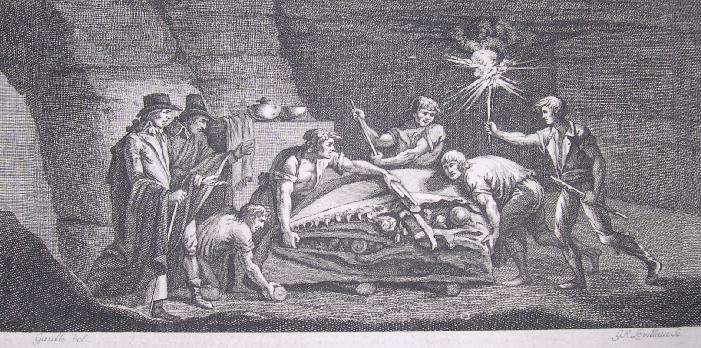 |
Mosasaurus hoffmanni - The First
Discovery of a Mosasaur?
Webpage created by Mike Everhart; Copyright ©
1999-2010
Last update - 05/14/2010
Left: Woodcut showing workers moving
a stone slab containing the skull of the first known mosasaur: Mosasaurus hoffmanni.
(Click for larger version) |
04/30/2004 - Translated into
French by Jean-Michel Benoit 
The story is told of how the first mosasaur was found deep in an underground
mine near the River Meuse and purchased by Dr. J. L. Hoffmann ... Well, sometimes such
stories are more fiction than fact. This version (translated by Joseph Leidy from a
chapter in the book published by Faujas Saint Fond (1799)) was re-published by Williston
(1898; 1914) in his description of mosasaurs:
| 84
University of Kansas Geological Survey. ...
The first specimen of Mosasaurs of which we have
historical knowledge was discovered by Doctor Hoffman, a surgeon of Maastricht, in 1780,
and has been the subject of numerous descriptions and discussions by some of the most
famous naturalists of the world. Its discovery, and the subsequent destination of the
fossil, is the subject of the following account by M. Faujas-Saint-Fond, in his
"Natural History of St. Peter's Mount":
"In one of the galleries or subterraneous
quarries of St. Peter's Mount, at Maestricht, at the distance of about 500 paces from the
principal entrance, and at ninety feet below the surface, the quarrymen exposed part of
the skull of a large animal imbedded in the stone. They stopped their labors to give
notice to Doctor Hoffman, a surgeon at Maestricht, who had for some years been collecting
fossils from the quarries, and who had liberally remunerated the laborers for them. Doctor
Hoffman, observing the specimen to be the most important that bad yet been discovered,
took every precaution to secure it entire. After having succeeded in removing a large
block of stone containing it, and reducing the mass to a proper condition, it was
transported to his home in triumph. But this great prize in natural history, which bad
given Doctor Hoffman so much pleasure, now became the source of chagrin. A canon [Godding]
of Maestricht, who owned the ground beneath which was the quarry whence the skull was
obtained, when the fame of the specimen reached him, laid claim to it under certain feudal
rights and applied to law for its recovery. Doctor Hoffman resisted, and the matter
becoming serious, the chapter of canons came to the support of their |
WILLISTON.]
Mosasaurs.
85 reverend brother, and Doctor Hoffman not only lost the specimen but
was obliged to pay the costs of the lawsuit. The canon, leaving all feelings of remorse to
the judges for their iniquitous decision, became the happy and contented possessor of this
unique example of its kind.
"But justice, though slow, arrives at last. The
specimen was destined again to change its place and possessor. In 1795 the troops of the
French republic, having repulsed the Austrians, laid siege to Maestricht and bombarded
Fort St. Peter. The country house of the canon, in which the skull was kept, was near the
fort, and the general, being informed of the circumstance, gave orders that the
artillerists should avoid that house. The canon, suspecting the object of this attention,
had the skull removed and concealed in a place of safety in the city. After the French
took possession of the latter, Freicine, the representative of the people, promised a
reward of 600 bottles of wine for its discovery. The promise had its effect, for the next
day a dozen grenadiers brought the specimen in triumph to the house of the representative,
and it \vas subsequently conveyed to the museum of Paris."
It is said that after peace was established the canon
was reimbursed for the specimen. But it still remains in Paris.
....
Editor's note: The mosasaur remains were sent to Paris and in 1808, Baron
Cuvier published the first comprehensive description of "le grand animal fossile de
Maastricht." Cuvier agreed with Adrian Camper, noting that the fossil's relationships
lay somewhere between iguanas and varanid lizards. |
A more complete version of this story by Faujas Saint Fond is found in a 2004 translation from the original French text by Jean-Michel
Benoit.
However, in an 1872 book by W.H.D. Adams, (Life in the primeval
world.), on pages 204-207 we see another version:
V. THE MOSASAURUS, OR GREAT ANIMAL OF MAESTRICHT.
The history of the discovery of the Mosasaurus is an interesting geological
romance. And no animal has been the cause of more lively controversies among
scientific men - a race much given to controversy. Maestricht, we need hardly
tell the reader, is a city of the Netherlands, built on the banks of the Meuse.
Among the hills on the western side of the river a solid mass of cretaceous
formation known as St Peter's Rocks has long been the site of some extensive
quarries. Numerous fossil remains were at different times discovered here, and
an officer of the garrison, named Drouin, formed a collection which, in 1766,
was purchased by the authorities of the British Museum. Drouin's example was
followed by a military surgeon, named Hoffmann, who, in 1780, purchased of the
quarrymen a remarkable fossil head, upwards of six feet in length.
So great a prize attracted very general attention, and the Dean of the Chapter
of Maestricht, one Goddin or Godwin, was induced to claim it from its purchaser
on the ground that he was proprietor of the land where the fossil had been
exhumed. He brought an action at law in assertion of his right, was successful,
and received the much-coveted treasure.
In 1793 the French army, under General Kleber, laid siege to Maestricht.
Attached to the staff as Scientific Commissioner was the celebrated geologist,
Faujas de Saint-Fond. Of all the spoils of the city Faujas coveted only the
celebrated" head;" and, at his request, when Maestricht was bombarded,
Goddin's house was' spared, just as, of old,
“The great Emathian conqueror bid spare
The house of Pindarus, wben temple and tower
Went to the ground." (Milton, "Sonnets," viii.)
The city surrendered. Faujas hastened to Goddin's mansion; but the much-coveted
fossil had been removed. It is said that the representative of the people who
then accompanied the army promised six hundred bottles of good wine to the
soldier recovering the precious spoil. On the following morning twelve
grenadiers triumphantly brought it into the camp; it was packed with the utmost
care, and dispatched to the Museum of Natural History in Paris. It is but fair
to add that its former proprietor was compensated for his loss with a handsome
sum of money.
Faujas de Saint-Fond immediately occupied himself in studying his fossil, and
published the result of his investigations in a work entitled, "Histoire
naturelle de la Montagne de Saint-Pierre, pres Maestricht" but he had been
anticipated.
Pierre Camper and Van Marum had obtained possession of fragments of the same
animal, exhumed in the same locality. They had purchased them of the heirs of
the surgeon Hoffmann; and persisted in attributing them to a whale, contrary to
the opinion of their original owner, who had ascribed them to a crocodile.
Adrian Camper, in 1790, directing his attention to the same subject,
demonstrated that the "animal of Maestricht" was neither a whale nor a
crocodile, but a new genus of saurian akin to the existing monitor. He pointed
out, as specially distinguishing this saurian from a crocodile, the polish of
the bones, the apertures in the lower jaw for the egress of the nerves, the full
solid root of the teeth, the attachment of the teeth to the palate, as well as
certain obvious differences in the vertebrae. Faujas, however, refused to
abandon his theory, until Cuvier descended into the arena, and, with all his
wonted sagacity and insight, demonstrated its absurdity. The Mosasaurus (or
"lizard of the Meuse ") was neither a crocodile nor an iguana; and
these two animals, said Cuvier, differ as much from each other in their teeth,
bones, and viscera, as the ape differs from the cat, or the elephant from the
horse.
But while the great French anatomist was thus calmly demolishing the unfortunate
Faujas, he himself, no less than the Campers, was the victim of a skillful
imposture, which has only been recently discovered.
We have referred to certain supposed remains of the Mosasaurus as having been
purchased by Pierre Camper from the heirs of Hoffmann, the surgeon. These
remains were forgeries! The pieces described by the two Campers, and by Cuvier
himself, were mostly fabricated by Hoffmann; as Schlegel, in the course of his
studies of the Mosasaurus, has discovered. His exposure of this singular fraud
is contained in a letter addressed to Prince Charles Bonaparte, and by the
latter communicated to the French Academy of Sciences.
The sagacity of Adrian Camper had detected that the ossicles of the extremities
of the Mosasaurus had been glued by Hoffmann to a block of chalk from the
Maestricht quarries.
When Schlegel came to examine this block more closely, he not only
perceived the truth of Camper's observation, but ascertained that the same
artifice had been employed for a considerable number of other pieces described
by Camper, and, after him, by Cuvier. Hoffmann had not contented himself with
excavating holes in the blocks of chalk, in filling them with plaster, and
attaching to them the remains or fragments which he intended to sell; but had
united into one several diverse bony pieces, and changed their apparent
character by partly embedding
them in the plaster, and by placing them one upon another.
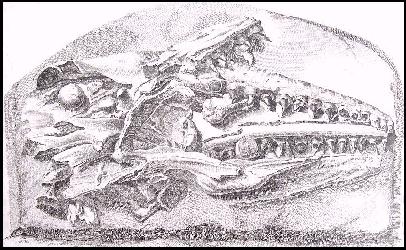 |
In 1822, the specimen finally
received its Linnean nominal when W. D. Conybeare referred to it as "Mosasaurus"
(Mosa-, the Latin name for the Meuse River near the town of Maastricht, and -saurus
for lizard. It was some years later when Gideon Mantell (1829:207) added the species name,
"hoffmanni" in honor of Dr. Hoffmann. |
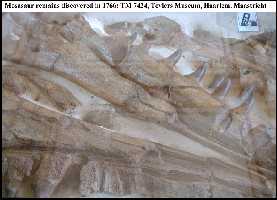 |
NEW INFORMATION: In his recent book, Mulder (2003; pers.
comm. 2003), reported that the first mosasaur skull, somewhat less complete than the type
specimen of Mosasaurus hoffmanni Mantell 1829, was actually discovered in 1766,
near St. Pietersburg, Maastricht and is still on exhibit in the the Teylers Museum, in
Haarlem (No. TM 7424). Mulder also noted that the specimen of Mosasaurus hoffmanni
described above was actually found between 1770 and 1774 (not 1780), and was never
actually owned by Dr. Hoffmann. According the Mulder, the Canon Godding was the
first legal owner. Hoffman, however, was the person who corresponded with other scientists
of the day and who got the attention of Camper and Cuvier. Go HERE
for more pictures of early mosasaurs specimens in the Tylers Museum, Haarlem, The
Netherlands. Left: Photo of the partial skull of the first specimen
(1766) of Mosasaurus in the Teylers Museum. The photo of a second specimen is HERE. Photos by Menno Slaats. |
|
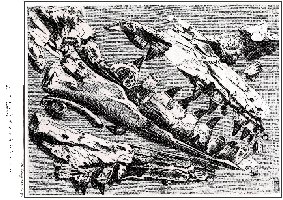
|
LEFT: ... and here's another twist.... This drawing
was published in 1790 by van Marum. According
to Mulder (2003), this is the "first documented find of a
mosasaur" occurred in 1766 at St. Pietersburg, Maastricht. The
specimen is still on display in the Tylers Museum in Haarlem, The
Netherlands... (no. TM 7424, ex Droulin Collection). Here
is a picture that I took of it in 2004 during the First Mosasaur Meeting.
|
|
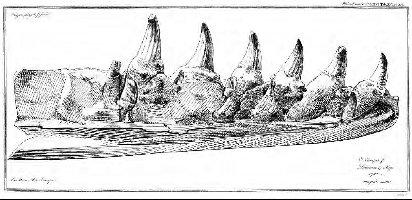
|
LEFT: As you might expect, there is a "rest of the
story"... Mosasaur bones had been seen before. In 1786 Pieter Camper
published a paper on "Conjectures relative to the petrifications found in St.
Peters Mountain near Maastricht." Although he was incorrect in regard to
the identification of the bones (he believed that they were whales) he did provide background
information on Dr. Hoffman that is considerably different than later
published by St. Fond and documented significant new
information about the creatures:
1) Comments on the pterygoid teeth
2) Comments on the openings in the dentary (foramina) for nerves
3) The first description of mosasaur vertebrae
4) Comments on tooth replacement
5) ...and he concluded that the specimen was not a crocodile.... |
|
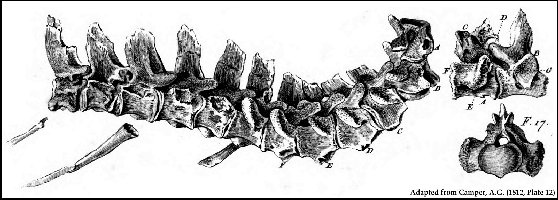
|
LEFT: Adrian Camper (son of Pieter Camper) was one of the
first to conclude (1800) that mosasaurs were closely related to Monitor
lizards, contra his father's idea that they were "whales." The
figures of mosasaur vertebrae at left were published in his 1812 paper. |
Credits:
The illustrations were adapted from "Mosasaurus hoffmanni, le Grand
Animal fossile des Carrieres de Maestricht: deux siceles d'histoire", by Nathalie
Bardet and John W. M. Jagt, Bulletin du Museum national d'Historie naturelle, Paris, 4
serie, 18, 1996.
The text is as credited above to Gordon L. Bell Jr. from Ancient Marine
Reptiles, 1997.
Photos from the Teylers Museum, Haarlem, by Menno Slaats.
References:
Adams, W.H.D. 1872. Life in the primeval world. London, 335 pp.
Bardet, N. and Jagt, J. W. M. 1996. Mosasaurus hoffmani, le
"Grand animal fossile des Carrieres de Maestricht": deux sicles d’histoire,
Bulletin de Museum d’Histoire naturelle, Paris, 4th Series, 18, Section C, No. 4, pp.
569-593.
Bell, G. L. Jr. 1997. Part IV:
Mosasauridae - Introduction. pp. 281-292 In Callaway J. M. and E. L Nicholls,
(eds.), Ancient Marine Reptiles, Academic Press, 501 pages.
Bell, G. L. Jr. 1997. A phylogenetic revision of North
American and Adriatic Mosasauroidea. pp. 293-332 In Callaway J. M. and E. L
Nicholls, (eds.), Ancient Marine Reptiles, Academic Press, 501 pages.
Camper,
A.G. 1800. Lettre de A.G. Camper à G. Cuvier, Sur les ossemens fossiles de la
montaague de St. Peter, à Maëstricht. Journal de Physique 51:278-291, pl. 1,
2.
Camper, A.G. 1812. Mémoire sur
quelques parties moins connues du squelette des saurians fossiles de Maëstricht.
Annales du Muséum d’Historie Naturelle 19:215-241.
Camper, P. 1786. Conjectures relative to the petrifications found in St.
Peters Mountain near Maastricht. Philosophical Transactions of the Royal Society
of London 76:443-456, pls. 15-16.
Leidy, J.
1865. Memoir on the extinct
reptiles of the Cretaceous formations of the United States. Smithsonian
Contributions to Knowledge 14(6):1-135, pls. I-XX.
Mulder, E.W.A. 2003. On latest Cretaceous tetrapods from
the Maastrichtian type area. Publicaties van het Natuurhistorisch Genootshap in Limburg,
Reeks XLIV, aflevering 1.Stichting Natuurpublicaties Limburg, Maastricht.
Saint Fond, F. 1799. Head of the Crocodile p. 59-67
in "Historie Naturelle de
la Montage de Saint-Pierre de Maestricht"; Translated from the French by
Jean-Michel Benoit.
Van Marum, M. 1790. Beschrijving der
beenderen van den kop van eenen visch, geveonden in den St. Pieterberg bij
Maastricht, en geplaatst in Teylers
Museum. Verhandelingen Teylers Tweede Genootschap 383-389, 1 plate, Haarlem.
Williston, S. W. 1898. Mosasaurs. The University
Geological Survey of Kansas, Part V. 4:81-347, pls. 10-72.





